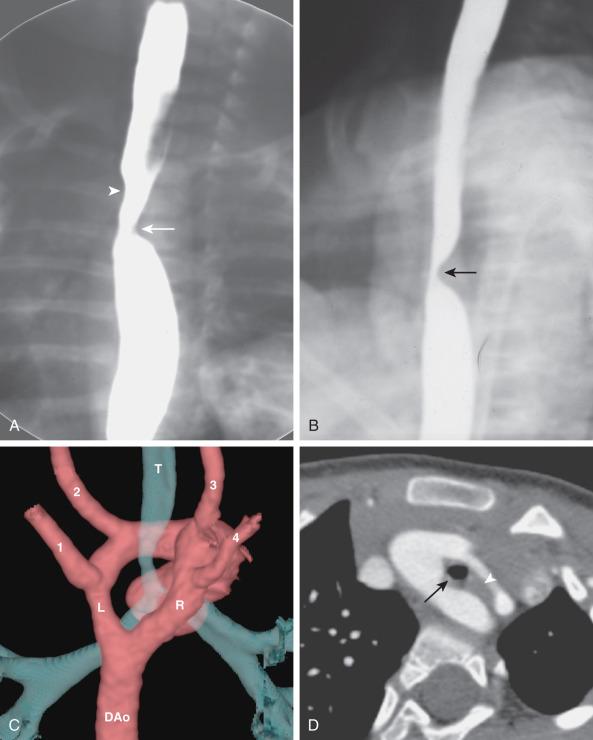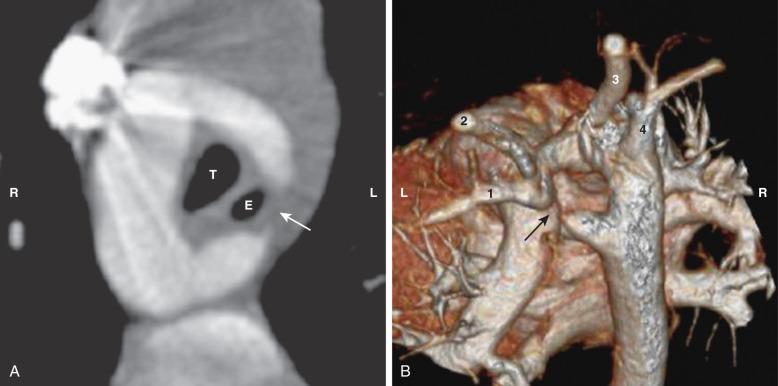Physical Address
304 North Cardinal St.
Dorchester Center, MA 02124
This chapter covers congenital anomalies of the great arteries that result in a vascular ring or sling. Overall, anomalies of the aortic arch and the cervical vessels are relatively common, with an estimated prevalence of 0.5% to 3%. They can be understood as the result of abnormal persistence and/or regression of branches in the totipotential arch, which is derived from the theoretical double aortic arch proposed by Jesse Edwards ( Fig. 76.1 ). The most common variations in arch branching are the common brachiocephalic trunk (common origin of the right subclavian and both carotids) and the arch origin of the left vertebral artery, estimated to occur in 8% and 4% of the population, respectively. These are of minimal clinical consequence and are considered normal variants.
Vascular ring is a term that refers to encirclement of the trachea and esophagus caused by the abnormal embryologic development of the aortic arch. This can be caused by the vascular structures of the aorta, the fibrous remnant of a ductus, the ligamentum arteriosum, or an atretic aortic arch. Only a small subset of aortic arch developmental anomalies leads to a vascular ring, accounting for less than 1% of all congenital cardiovascular defects. Although about a dozen different types of vascular rings exist, the most common are a double aortic arch and a right aortic arch with a retroesophageal left subclavian with left ligamentum arteriosum. They can occasionally be associated with other congenital heart defects.
Chromosome 22q11 deletion causes abnormalities in aortic arch and conotruncal development, and has been reported in 24% of patients with isolated arch anomalies. Testing for this chromosomal abnormality should be considered if there are other congenital heart defects or dysmorphic features.
The severity of symptoms and the age of onset depend on the extent of the compression of the esophagus and trachea. Patients may be completely asymptomatic or may present with significant respiratory distress. A high index of suspicion is necessary due to the nonspecific symptoms and rarity of a vascular ring compared with other diagnoses. It is not uncommon for the diagnosis of vascular ring to be preceded by a history of reactive airway disease or recurrent croup.
The clinical presentation most commonly includes respiratory symptoms like stridor, “barky” cough, wheezing, and frequent upper respiratory infections. Symptoms related to constriction of the esophagus are dysphagia, recurrent emesis, and failure to thrive. Esophageal symptoms are more commonly seen in older infants as they start taking solid foods. Because the trachea and esophagus share the same space within the ring, respiratory symptoms can worsen during feedings. Patients with double aortic arch tend to present earlier with more severe symptoms compared with other vascular ring types.
Chest radiography may show tracheal compression by a vascular ring, but by itself a chest radiograph cannot confirm or exclude a vascular ring. Because a vascular ring is more likely in the presence of a right aortic arch, symptoms of tracheal compression in the presence of a right aortic arch should raise the possibility of a vascular ring.
Historically a barium esophagram was considered the initial test of choice in the evaluation for a vascular ring. Other imaging modalities are now utilized in lieu of an esophagram, although occasionally a vascular ring can be discovered incidentally when an esophagram is ordered to evaluate for other diagnoses such as gastroesophageal reflux, aspiration, or tracheoesophageal fistula ( Fig. 76.2 ).

Echocardiography with gray scale and color Doppler imaging may visualize the vascular ring directly in neonates and infants because these patients have excellent sonographic windows, particularly if the ductus is patent. Generally echocardiography is not as useful for diagnosing a vascular ring in older children and adolescents due to limited acoustic windows. Its main utility is in the assessment for concomitant congenital heart disease. The presence of a vascular ring has been diagnosed accurately in utero with fetal echocardiography, where the airways are seen reasonably well and the ductus arteriosus remains patent.
Patients with a high suspicion for a vascular ring should undergo vascular imaging to confirm the vascular abnormalities and to gather information for surgical planning. Contrast-enhanced computed tomographic angiography (CTA) or magnetic resonance angiography (MRA) are the preferred modalities. Both can visualize the course and morphology of the intrathoracic vessels well. The advantage of MRA is the absence of ionizing radiation, although sedation or general anesthesia is often necessary before the age of 8 years. CTA provides superior spatial resolution and visualization of the airway compared with MRA, and newer multidetector scanners can typically obtain this imaging without sedation.
The definitive treatment is surgical division of the ring via a lateral thoracotomy. A double aortic arch is repaired by dividing the nondominant (smaller) arch between its last cervical artery and the point where it joins the descending aorta. Whether the arch is patent or atretic should be noted. If the ductus arteriosus or the ligamentum arteriosum forms a border of the ring, it is ligated. Persistent stenosis or tracheomalacia may develop in the constricted trachea, requiring additional repair.
Double aortic arch is the most common vascular ring. The head and neck branches arise symmetrically from the two arches, and their parallel orientation in axial imaging can serve as an imaging hint that a double aortic arch is present. Embryologically, the persistence of both the right and the left fourth aortic arches and distal dorsal aortic segments results in the double aortic arch. Two vessels, the right and left carotid arteries and right and left subclavian arteries, arise symmetrically from the ascending aorta and course dorsally, one on each side of the trachea and esophagus, to join the thoracic descending aorta. The descending aorta is on the left in 80% of cases. The larger aortic arch is considered the dominant arch, with the right being dominant in 75% of cases. The ductus arteriosus is usually left-sided but can be right-sided or bilaterally present. Bilateral patent arterial ducts can increase the severity of the tracheal and esophageal compression.
One portion of one aortic arch may be atretic, almost always occurring on the left. Double aortic arches with left arch atresia develop from regression of varying segments of the left aortic arch, with fibrous continuity of the segments completing the vascular ring. The atretic segment may lie between the left subclavian artery and the descending aorta ( Fig. 76.3 ) or between the left common carotid artery and the left subclavian artery. The former configuration is similar to a right aortic arch with a mirror-image branching pattern, and the latter configuration is similar to a right aortic arch with an aberrant left subclavian artery. However, a right aortic arch with mirror-image branching is almost always associated with significant congenital heart disease, and its absence should raise suspicion for a double aortic arch. An aortic diverticulum may be present posterior to the esophagus, which is part of the distal left aortic arch, before connecting to the aberrant left subclavian artery. Patients with atresia of a portion of one of the arches tend to have more severe tracheal and esophageal compression (see Fig. 76.2 ). Echocardiography does not provide optimal imaging for a double aortic arch, particularly if there is an atretic segment. Although it is recommended to screen for congenital heart defects, double aortic arch is not usually associated with significant abnormalities. CTA and MRA can readily visualize the atretic segment that appears to tether adjacent vascular structures and can be used to identify the associated aortic diverticulum.

Become a Clinical Tree membership for Full access and enjoy Unlimited articles
If you are a member. Log in here